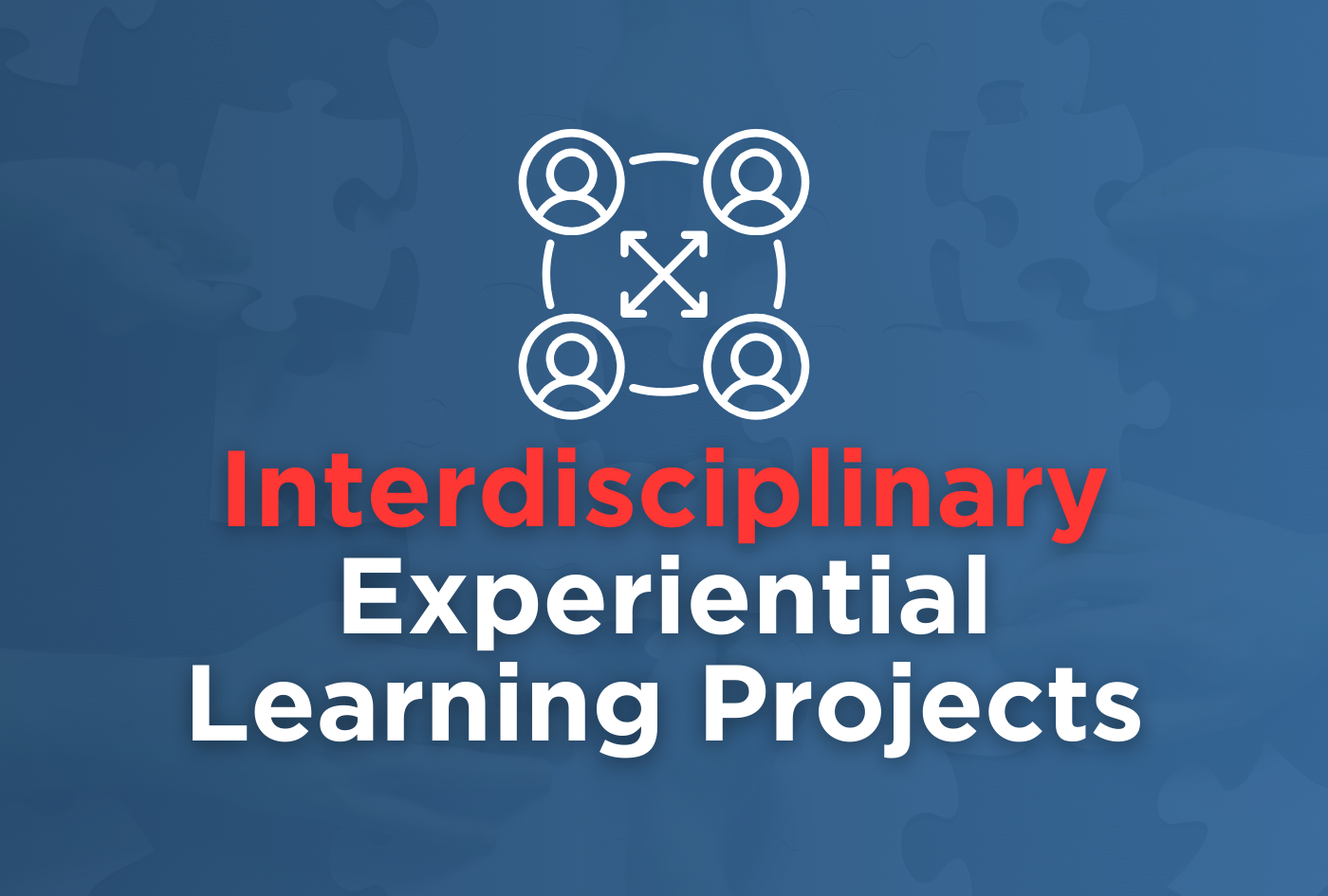Experiential Learning projects with live sponsors or clients bring real-world, career-relevant experience to students, but they are often limited to individual academic disciplines, restricted to live projects that fit within the course’s scope. As with everything curricular, there is a continuum and all varieties of Experiential Learning, from case study-based teamwork to live client projects, are valuable. Single-discipline Experiential Learning projects are no different, but we love the all-in, maximum real-world nature of interdisciplinary client projects. We spoke with four EduSourced schools who do interdisciplinary projects to break down their challenges, benefits and the outcomes of implementing interdisciplinary projects.
Why Do Interdisciplinary Experiential Learning Projects? Preparing Students for the Real World
Every program interviewed for this article identified the real-world side of interdisciplinary projects as the key reason to do them. Real industry and community challenges rarely fit into a single discipline box and so professional environments require collaboration across different areas of expertise. Beyond a richer student experience, interdisciplinary projects are cited by three of the four the programs we interviewed as being easier to source since the coorespond more directly with industry need.
Most projects are interdisciplinary by nature. If we only focused on single discipline projects, we’d be missing opportunities for our students to work on the interesting problems. Since our program includes students from Biomedical, Computer, Electrical, Industrial & Systems, and Mechanical Engineering, we are able to pursue a broad array of projects with a higher likelihood of successful outcomes.
Dr. Beth DeBartolo, Director of Multidisciplinary Senior Design, Rochester Institute of Technology
Beyond offering students an even more career-relevant experience, interdisciplinary projects carry secondary benefits for students like enhanced communication skills. Grappling with the language of different disciplines both requires students to represent their own discipline clearly and stretch to understand the basics of their teammates’ disciplines. Even if a student’s specific role within their project represents a single discipline, they will still need to interface effectively with teammates from different academic backgrounds. Ensign College’s Michael Ray has found that working in interdisciplinary teams can help students understand the interdisciplinary nature of real-world projects as well, something single discipline courses can obscure.
Interdisciplinary projects make it possible for students to work on more realistic and challenging projects that are more likely to motivate and interest them. Other student benefits include: increases the breadth of their engineering experience, gives them exposure to career possibilities outside of their discipline, fosters the development of better teamwork and communication skills, and helps students grow their network outside of their discipline.
Dr. Robert Hart & Dr. Todd Polk, UTDesign Capstone Faculty Directors
Interdisciplinary Projects Align Better with Industry
Employers approach problems seeking comprehensive solutions that are not necessarily segmented by academic discipline. Offering project sponsors the opportunity to engage a student team with multiple skill sets reduces friction in recruitng projects by meeting them where they are. Enhanced scope: by including multiple disciplines, these projects can be more substantial than single-discipline-based projects.
Multidisciplinary projects are easier to source [than single-discipline projects]. Clients are usually not concerned about the make-up of the team, they just want to get the work done. In addition, Clients are already used to multidisciplinary project teams in their companies. We present UTDesign to Clients as a single entry point for engaging with a capstone team. After we understand the scope of the project, we determine what mix of engineering disciplines is needed on the project team.
Dr. Robert Hart & Dr. Todd Polk, UTDesign Capstone Faculty Directors
Businesses think of projects as business solutions, not just the academic discipline aspect of a problem.
Roger McCarty, Coordinator of Project-based Internships, Ensign College
Challenges for Interdisciplinary Experiential Learning
When asked if interdisciplinary projects are worth the effort, all four programs interviewed were an enthusiastic yes. That said, there were some challenges and additional complexities with this model that were shared.
Increased complexity compared to single-discipline projects. For students, there can be a risk involved as you are relying on each team member to be competent in their respective area, which might not always be the case. This is especially challenging if only one student on a project represents their discipline. This also means the project is easier to fail if one team member isn’t strong. Projects that incorporate a large number of disciplines, such as five or six, can be more challenging than those with only two or three, primarily because it becomes harder to ensure multiple students are available for each specific discipline on a given team.
Tools of the trade: Smart Match, the flexible, automated team matchmaking tool in EduSourced, supports allocating students by professional and/or academic background. You can set projects to require a specific mix of majors, for example, to alleviate the issue of having a team rely on a single student to represent their discipline.
For students, working across different fields can lead to frustration, particularly when team members are “speaking a different technical language.” Students and instructors need a little more patience as students grapple with understanding aspects of the problem that fall outside their primary discipline and figure out how to communicate effectively across discipline lines. Grappling with these communication challenges in a capstone setting, however, is preferable to encountering them for the first time on a job.
There can also be potential downsides for the clients or the project itself. There is a risk of having “too many cooks in the kitchen, or not doing something substantial” according to Ensign College’s Michael Ray. The focus of a project can sometimes change as it evolves, which could complicate a team’s skill balance resulting in students from one specific discipline not being able to fully contribute their expertise.
It’s important to give more thought to how teams are assigned and the balance of majors on different projects to ensure appropriate staffing. If a program utilizes a separate, general multidisciplinary course option, a drawback noted is the uncertainty of which majors will enroll, which can make it hard to recruit suitable projects in advance without knowing the available students’ backgrounds. Instructor background can be a challenging factory too since no one is an expert in everything. Employing co-instructors or expert mentors to teams to help add expertise can help.
Deeper dive: this article details the value mentors can bring to Experiential Learning projects. While leveraging mentors is not an interdisciplinary-specific strategy, it can help bolster available expertise which can be especially in interdisciplinary settings.
You have to give more thought to how your teams are assigned and the balance of majors on the different projects, but we have a system in place and it’s manageable. I think you also have to have a little more patience with the students as they grapple with understanding aspects of the problem that are outside their discipline, and as they figure out how to communicate across discipline lines.
Dr. Beth DeBartolo, Director of Multidisciplinary Senior Design, Rochester Institute of Technology
Practical Insights for Building and Running Interdisciplinary Project-based Learning
A key theme from our conversation with these four programs is to start small, if you are considering branching into interdisciplinary projects for the first time. This allows room for developing your own process for supporting interdisciplinary teams and building acceptance with instructors and any other collaborators who help support your program. Starting small provides an opportunity to build inroads with other departments or schools to help support your interdisciplinary program with the expertise needed.
Gaining faculty buy-in is also important; this can be facilitated by initially offering projects that clearly benefit from including students from different disciplines and by allowing students to opt into the multidisciplinary option. Over time, this can shift the perception of what is the “normal” way of doing things, as it did at UT Dallas. Structurally, minimal changes might be needed if disciplines share similar core processes (e.g. a required senior design in engineering), but exploring options like merging courses across disciplines or ensuring related courses are scheduled concurrently can make it easier for students to participate.
Recruiting expertise for multiple disciplines can involve having a faculty team review projects and work together, seeking instructors with a breadth of experience, co-teaching to complement knowledge, and having advisors who provide guidance rather than needing deep subject matter expertise in every specific project area. Developing a stable of mentors from relevant disciplines is also advised as a best practice, but by no means required to get started!
Start small with one or two teams and determine what processes and procedures are needed in your program to make it work. This will also give you a chance to develop relationships with instructors outside of your department. It is also very helpful if the instructors agree on the material to be presented so that what is presented is the same for both/all disciplines if they are taught separately. Once this step is achieved, then the instructors can explore merging the courses across disciplines.
Another important lesson that we learned is that it is important to get department capstone courses scheduled at the same time so that students have the flexibility to cross over between courses.
Dr. Robert Hart & Dr. Todd Polk, UTDesign Capstone Faculty Directors
Has it Been Worth the Effort?
The logistics of implementing interdisciplinary projects are the reason so many schools we talk to have not yet launched these programs. We asked these four programs if they were personally involved when they switched to the interdisciplinary model, how the conversion was done and if it has been worth the effort.
Elizabeth Debartolo at RIT College of Engineering: I was involved with bringing the last department into the [interdisciplinary capstone] program as a late addition. There were very minimal structural differences – we all follow basically the same engineering design process – so it was more a matter of building faculty buy-in. We started by offering a couple of projects that would benefit from the inclusion of that department’s students and convinced the department to allow students to opt in to the multidisciplinary capstone, and I visited the pre-requisite class to let them know about the opportunity. Within two years, we had more students from that department opting for the multidisciplinary capstone than their single-discipline capstone, and even the department’s industrial advisory committee asked why all their students weren’t taking a multidisciplinary capstone. It took four years from my first visit to the pre-req class before they dropped their single-disciplinary capstone. That may sound like a long time, but considering it took very little effort and generated no real resistance among the faculty, it was worth it.
Ed Riefenstahl at TCU Neeley School of Business: I was hired to launch what became Neeley & Associates Consulting (N&A). I was advised by the Associate Dean of Graduate Programs who hired me to do this to pay faculty for their work. I structured it so that as a faculty SME, the person knew that they had to meet a minimum of three times at certain points in the program’s “Roadmap to Success” for a period of 6 to 10 hours during the spring semester when this elective was offered to interested 1st-year MBAs, the target cohort at that time. Neeley & Associates is now open to any graduate business student.
Each of our projects are supported by a N&A Resource Team consisting of: 1. a paid faculty or staff SME, 2. a 2nd year MBA leader, called a Principal in our program, who is also paid to lead a team and had served as a N&A Consultant the previous year, 3. volunteer consulting professionals who I had recruited to serve on an advisory board I initiated and who assist with project scoping and conducting independent quality assurance reviews. Finally, my meeting with each team on 3 occasions for formal status reviews.
Robert Hart and Todd Polk at UT Dallas Engineering: It was a process that we started slowly and ramped up as we gained experience and acceptance. For our biomedical and mechanical engineering departments, we reached a point where it made sense to combine the two capstone courses. It has gotten to the point now where students feel like this is the “normal” way it is done. For other disciplines, we merge the students into our class when they work on an interdisciplinary project. We may have benefitted from doing this early in the development of our programs, but we have not had any resistance from administration and they have been supportive of our efforts. One important lesson that we learned is that it is important to get department capstone courses scheduled at the same time so that students have the flexibility to cross over between courses. It has definitely been worth the extra effort.
Michael Ray and Roger McCarty at Ensign College: We did interdisciplinary projects [previously with a third-party partner called RBDC] but the projects were pre-digested by our partner with defined outcomes and deliverables before assigning students. This is not real-world and hence, wasn’t optimal. When experiential project based internships were initially started here there was not a history of projects implemented on the campus that were multidisciplinary. So the project based internship were the first large scale multidisciplinary projects attempted.




